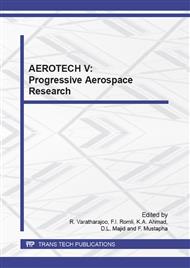p.467
p.475
p.481
p.487
p.493
p.498
p.503
p.507
p.513
Low Velocity Impact on Woven Kenaf Fiber Reinforced Composites
Abstract:
This paper presents the experimental investigations on the low velocity impact response of woven kenaf fiber reinforced composites. Kenaf yarns are weaved with an orientation of 00 of warp and 900 of weft to form woven kenaf mat. Three woven kenaf mats are stacked together to achieve the specified sequences. The woven stacked kenaf mats are hardened with polymeric resin and compressed to squeeze off any excessive resin and to minimize voids content. The hardened composite plates are perforated using different impact velocities. Impact responses of the composite plates are examined according to stacking sequences, impact velocities and fragmentation patterns. According to the present results, the impact strength is strongly related with the impact velocity. If higher impact velocity is used, the performances of load bearing are reduced. It is obvious that no significant features of composite fragmentations occurred from the perforated holes. However, relatively larger area of mechanical damages is found distributed around the holes, indicating the capability of composites to absorb energy effectively.
Info:
Periodical:
Pages:
503-506
Citation:
Online since:
October 2014
Authors:
Price:
Сopyright:
© 2014 Trans Tech Publications Ltd. All Rights Reserved
Share:
Citation:


